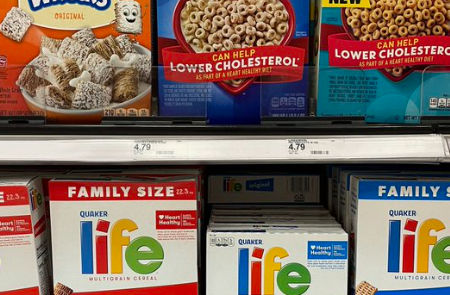Companies are looking to cut costs, while ripping off consumers who have no idea they are getting less and less per container.
In the latest episode of Planet Money over on NPR, they explored the intriguing world of package sizes and how companies tweak them to maximize profits—a strategy known in the industry as “price pack architecture.” This tactic has become increasingly prevalent over the past few decades, prompting discussions about both its benefits and drawbacks for consumers.
Read “How to fight shrinkflation? Pay attention to unit prices at grocery stores” on SmartNews: https://t.co/w7PBmVLgI3 #SmartNews
— M.Wells (@MWells96042945) July 9, 2024
While offering different package sizes can indeed provide more choices—like opting for a quart of chocolate milk instead of a gallon—there’s a less favorable side to this strategy. A notorious example is shrinkflation, a subtle yet impactful form of inflation where companies reduce the quantity of a product in a package without lowering the price, effectively raising the cost per unit. This tactic was even highlighted in this year’s State of the Union address, underscoring its significance in the consumer market.
Mr North: When did the Slim#1 become victim of “shrinkflation” & did it happen overnight? Yesterday, I bought two Slim#1 sandwiches & they were the length of this Cubano. Today I was told the smaller length sandwich seen here is the correct size of a Slim#1. What nonsense: pic.twitter.com/lkRnBC8iZW
— Dish Central by C.J. (@DishCentral) July 9, 2024
Despite these manipulations, there’s a straightforward way for consumers to ensure they’re getting the best deal: by paying attention to unit prices. Many stores help by listing the price per ounce directly on the price tag, a practice that varies by state due to differing legislation. Only 19 states have laws regarding unit price displays, and among those, just nine require that this information be clearly provided to shoppers. For instance, New Jersey takes this regulation seriously, as evidenced by a recent fine imposed on a major retailer for not accurately displaying unit prices, which resulted in a significant penalty.
#shrinkflation @WallStreetSilv pic.twitter.com/QiTcK0N3DA
— Finance Reb (@FinanceReb) July 9, 2024
The ability to compare unit prices easily can significantly influence purchasing decisions. Research by the Food Marketing Institute shows that 78% of shoppers utilize unit prices when available to determine the best value. However, in states where this practice isn’t mandated, consumers may find themselves pulling out their smartphones to calculate the cost per unit manually. This can be cumbersome, but it empowers consumers to make more informed choices, ensuring they are not unwittingly penalized by clever packaging strategies.
For those who find the math too tedious, the alternative could be advocating for local or state policies that require stores to display unit prices, simplifying shopping and promoting consumer rights.
Key Points:
- “Price pack architecture” is a common strategy where companies adjust package sizes to increase profits, often leading to consumer challenges.
- Shrinkflation, where companies reduce the amount of product in packages but keep prices the same, effectively raises per-unit costs, drawing attention in national discussions.
- Consumers can protect themselves by focusing on unit prices, which compare costs per unit of product, though availability of this information varies by state.
- In New Jersey, strict enforcement of unit price display laws recently led to a significant fine for a retailer, highlighting the importance of this issue.
- For states without mandatory unit price displays, consumers may need to calculate these figures manually, which can influence shopping habits and prompt calls for legislative change.
TL Holcomb – Reprinted with permission of Whatfinger News



